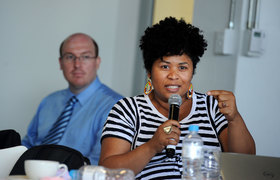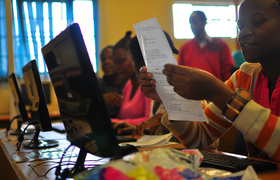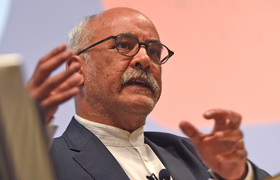Interactive website tracks SA’s post-school qualifications
16 October 2020 | Story Niémah Davids. Photo Brenton Geach. Read time 5 min.
In 2020 approximately 14% of South Africans managed to attain a post-secondary school qualification – a 7% increase compared with figures from 1994. While there has been steady progress over the past 25 years, achieving governmentʼs target of 22% by 2030 will take work.
This target is one of the National Development Planʼs (NDP) 14 priorities for improving education, training and innovation.
Siyaphambili (We are moving forward), a project of the Southern Africa Labour and Development Research Unit (SALDRU) at the University of Cape Town (UCT), will play a fundamental role in helping to track and monitor the country’s progress in the next decade.
The initiative, which forms part of SALDRU’s post-school education and training research project, studies the number of young South Africans who attain qualifications after high school and those who do not. It has been tracking post-school qualifications since 1994.
This data helps researchers to understand and create awareness around the type of skill sets that are lacking in the country and demonstrates other shortfalls that need to be addressed to fast-track economic growth.
On Wednesday, 14 October, Siyaphambili launched an interactive website to track, showcase and streamline its work.
Simple measurement
According to Dr Nicola Branson, the principal investigator for the Siyaphambili post-school research project, the website provides a very simple measurement using publicly available data from Statistics South Africa on a platform that is easily accessible to all South Africans.
“The website is a public interactive platform that uses publicly available, accurate data to communicate. The NDP has set out an ambitious goal and it requires collaboration from everyone in the system – all stakeholders – in order to move forward,” Branson said.
“[It] provides us with a platform to monitor the proportion of South Africans who are between the ages of 15 and 64 years and have a post-school qualification.”
This, Branson explained, refers to a degree, diploma or certificate obtained from a public or private university, college or post-school institution.
“It’s any qualification.”
Funded by the Kresge Foundation, the website has been inspired by the United States Lumina Foundation’s Stronger Nation website, which similarly tracks and monitors Americans’ post-school qualifications. By 2025, 60% of Americans should hold “credentials beyond high school”.
Surveying the data
Though South Africa enjoys relatively high levels of primary and secondary school participation, the level of post-secondary school qualifications remains low.
“Data shows that South Africa has very high returns on post-school education. A university graduate can earn up to three times the amount of someone who matriculated, or up to five times the amount of someone who passed Grade 8,” Branson said.
Siyaphambili studies post-school qualification attainment by population group, gender, age group and province. The data indicates that since 1994, the share of the white and Indian populations with post-school qualifications increased by 15%, while the share of the coloured and black populations increased by 7%.
The data also shows that a higher proportion (14.75%) of women obtained post-school qualifications when compared with men (12.86%) in the 25-year period. All age groups surveyed have demonstrated steady growth. However, the oldest surveyed age group (36–64) recorded the highest increase (17.58%) since 1994, followed by the 25–35 age group at 16.45% and the 15–24 age group at 4.59%.
Proud moment
Professor Murray Leibbrandt, the director of SALDRU, said that the launch of the website was a proud moment for the team. He reiterated the unit’s commitment to conducting “excellent” research that has a direct impact on poverty and inequality in South Africa.
According to Leibbrandt, Siyaphambili has been carefully designed as an important intervention in a crucial space, which he said is necessary to build a more impactful higher education sector.
“This afternoon brings together a family who has been working on this project [research and website] together,” he said.
“It’s lovely to take stock of where we are and to work out how we can do better.”
 This work is licensed under a Creative Commons Attribution-NoDerivatives 4.0 International License.
This work is licensed under a Creative Commons Attribution-NoDerivatives 4.0 International License.
Please view the republishing articles page for more information.










